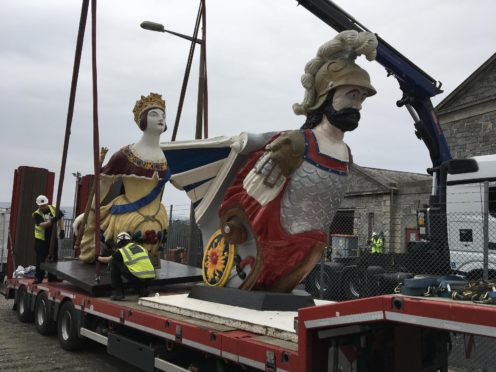Giant figureheads built for 19th-century warships have been restored following years of decay and rot.
Conservation experts spent two years restoring the wooden objects.
The 14 figureheads, which include a depiction of a young Queen Victoria, had suffered water damage.

Many were so severely damaged that their insides resembled “saturated compost,” conservator Hans Thompson said.
“Imagine walking through a forest, that nice smell of rotting vegetation. We were pulling the (insides) away with our hands. They were that degraded,” he told the PA news agency.
The damage occurred after the ships were destroyed and the figureheads were scattered around the country.

“It was considered bad karma to wantonly destroy them when they broke up the ships because they were seen as the soul of the ships,” Mr Thompson said.
“So they had acres and acres of these objects and they ended up going to village greens, parks, end of peers and naval establishments.
“They were put on display outside, in the elements, and not properly maintained.

“The water would get in and rot would start.”
Treatments in the 1960s only added to the problems, said Mr Thompson, who worked with Orbis Conservation co-founder Maxwell Malden on the project.
“Brown rot eats from the inside out. Fortuitously it hadn’t eaten all the way through to the surface.”
The monumental objects – the largest being four metres high – have “extraordinary histories”.

“We found a musket ball in one of them and boreholes from larvae the size of which you’d never see in Europe, clearly from tropical beetles. They’ve lived quite exciting lives,” Mr Thompson said.
Due to the size of the objects, conservation teams in London, Devon and Cornwall pioneered a new technique to repair them.
A set of 1912 full colour cigarette cards with the Navy’s most famous figureheads were tracked down, to help replicate the original colour schemes.
Figureheads include HMS Topaz, a female bust carved in 1858, from a ship which removed two of the Easter Island statues now in the British Museum.

Another was from a ship on which sailors fought pirates off the coast of West Africa and served during the Crimean War.
The largest is HMS Royal William, dubbed King Billy, a figure of William IV carved in 1833.
Following the “massively challenging” conservation project, the objects will go on display in Plymouth, where almost all of the figureheads were originally made.
Weighing over 20 tonnes collectively, they will be suspended from the ceiling of The Box to “create the effect of a fleet of carvings floating in space”, when the museum and art gallery opens in spring next year.
The figureheads are on loan from the National Museums Of The Royal Navy.
Tudor Evans, leader of Plymouth City Council, which together with The Box funded the restoration, said: “The figureheads are more than just wooden sculptures, they’re iconic symbols of the history of the city of Plymouth and the Royal Navy. They’re also fantastic representations of the craftsmanship and skill of the sculptors who made them over 200 years ago. ”
More information is at
https://plymhearts.org/thebox
.
